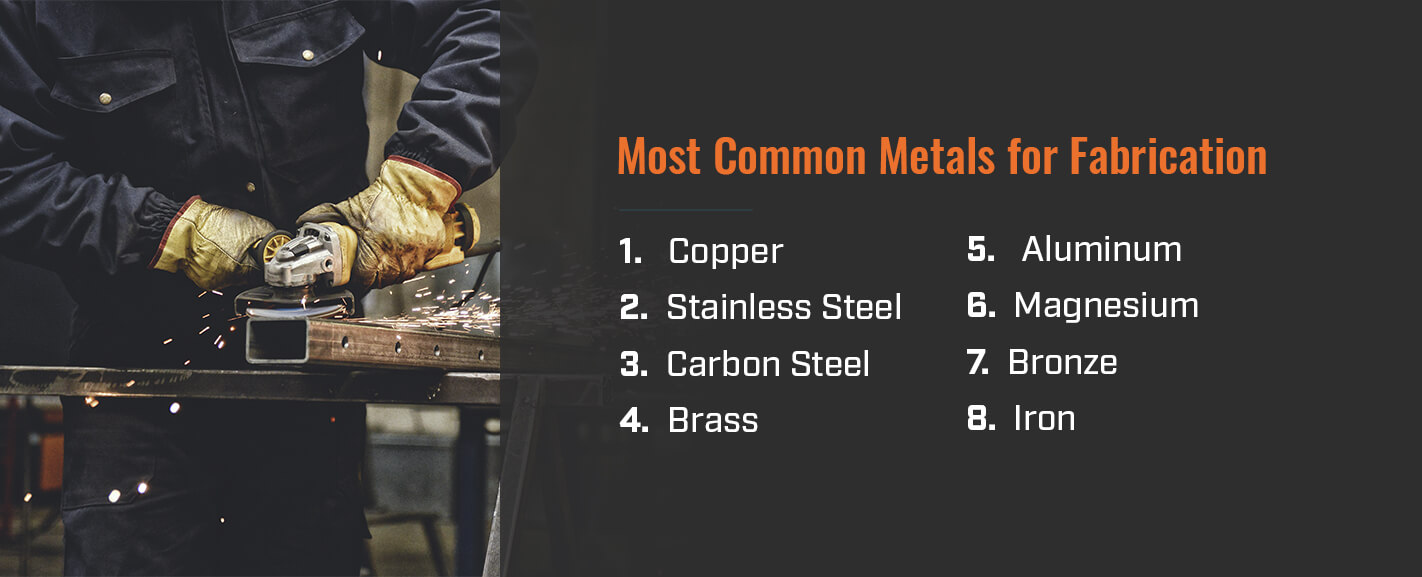
The metal fabrication process looks a number of different ways depending on the metal you are working with and the method you are using. Choosing the right metal depends on the end goal of your project.
Many of the products in your life have gone through the metal fabrication process, whether you realize it or not. It is the process of manufacturing various types of metal into different shapes specific to the product they are a part of.
This process requires skill and technical experience through stamping, welding, folding, cutting and shaping. Commercial businesses with both general and customized needs use metal fabrication.
A variety of technology is used in metal fabrication, from laser technology to computer software to plasma cutting.
The metal fabrication process can take several forms as products are created for both the custom and stock needs of companies:

Various metals are used in metal fabrication. A large span of industries can use many of these metals due to the unique traits they have. Other metals are used almost solely in certain industries for the same reason. Knowing which metal is best for fabrication really depends on what your end goal is for your project.
Here are some of the most common metals used in the metal fabrication process:
Copper is a metal that is widely used for metal fabrication due to its ductility, malleability, thermal and electrical conductivity, natural antimicrobial property and corrosion resistance. Because of its ability to stand up to thermal and electrical activity, it is often used in heating and cooling systems, roofing and pipe systems. Marine and industrial industries are the most likely to use copper in various contexts.
Stainless steel combines carbon steel, chromium, aluminum and other elements to create a metal that is a popular material for a variety of uses and is highly corrosion-resistant. Stainless steel comes in five categories, which are austenitic, ferritic, martensitic, duplex and precipitation hardening.
The metal is brittle, lustrous, does not tarnish and has an aesthetic silver mirror coating. Stainless steel’s unique and durable properties allow it to be used in a variety of applications, such as surgical instruments, appliances, cookware, metal ceramics, collectibles and cabinet fittings.
Carbon steel boasts a versatile design that is durable and not too difficult to work with. This is one of the most common metals for fabrication. It can withstand harsh weather, making it a welcome choice in the construction industry. The hardness of carbon steel can change based on the amount of carbon in the mixture. However, more carbon causes the malleability, ductility and melting point to decrease.
Brass is not quite as common as some others on this list, but it still makes an appearance in a variety of industries. The metal is an alloy made of copper and zinc and the amount of each depends on what the intended use of the final product is.
Brass is easy to form, but once it is cooled, it is durable and hard to mold further. You can find brass being used in bathroom fixtures, medical applications, musical instruments and ammunition components.
Aluminum is produced through a unique process. First, the bauxites that contain aluminum are extracted from the ground. They are then processed into aluminum or alumina oxide before going through an electrolytic reduction through which pure aluminum is created.
This metal has a desirable strength-to-weight ratio and exceptional workability, natural corrosion resistance and good thermal and electrical conductivity. You will be able to use a piece of aluminum over and over again, as it is infinitely recyclable and does not lose quality.
It is often used in household appliances, aircraft, power lines, window frames, industrial appliances and spacecraft components.
Magnesium is high in strength, low in density and the lightest structural material at the same time. It is a great option for projects that require a stiff material. Magnesium is often used for handles, locks, latches, aircraft housing, automobile parts and parts of machines that rotate rapidly.
Bronze is proven to be a tried and true material for a variety of uses. Bronze is heavier than steel and stronger than copper. It has a lower melting point than many other metals. You can most often find bronze used in things like coins, cookware, armor, weapons and turbines.
Iron is the most common element on earth when determined by mass, which makes it a great option for a lot of industries. It is used in the production of steel or by itself.
PBZ Manufacturing is a one-stop shop for engineering, manufacturing, finishing, assembling and shipping. We remove excess layers from your supply chain and reduce the time your project takes and your manufacturing costs. Our knowledgeable staff and certified welders are ready to help you through your project every step of the way.
Contact us today to find out how we can enhance the quality of your project, or request a quote if you’re ready to take the next step.
Manufacturing is in our DNA. Since Paul B. Zimmerman opened his small welding and repair shop in 1947, we've remained true to our roots: metal manufacturers serving in the Spirit of Christ. We're committed to carrying forward the service and business principles that brought us here. We're also passionate about advancements in technology and continuous improvements to meet your needs. It's why we have expanded our manufacturing and assembly capacity and added new flat and structural lasers.
Our new logo honors this legacy while signaling an exciting future of advanced capabilities and expanded capacity. We're committed to giving your ideas shape. What can we make for you?